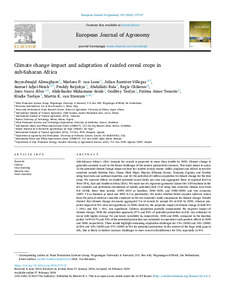| dc.contributor.author | Alimagham, S. |
| dc.contributor.author | van Loon, M.P. |
| dc.contributor.author | Ramirez-Villegas, J. |
| dc.contributor.author | Adjei-Nsiah, S. |
| dc.contributor.author | Baijukya, F. |
| dc.contributor.author | Bala, A. |
| dc.contributor.author | Chikowo, R. |
| dc.contributor.author | Silva, J.V. |
| dc.contributor.author | Soule, A.M. |
| dc.contributor.author | Taulya, G. |
| dc.contributor.author | Tenorio, F.A. |
| dc.contributor.author | Tesfaye, K. |
| dc.contributor.author | van Ittersum, M.K. |
| dc.date.accessioned | 2024-03-04T08:51:52Z |
| dc.date.available | 2024-03-04T08:51:52Z |
| dc.date.issued | 2024-02-24 |
| dc.identifier.citation | Alimagham, S., van Loon, M.P., Ramirez-Villegas, J., Adjei-Nsiah, S., Baijukya, F., Bala, A., ... & van Ittersum, M. (2024). Climate change impact and adaptation of rainfed cereal crops in sub-Saharan Africa. European Journal of Agronomy, 155: 127137, 1-13. |
| dc.identifier.issn | 1161-0301 |
| dc.identifier.uri | https://hdl.handle.net/20.500.12478/8417 |
| dc.description.abstract | Sub-Saharan Africa’s (SSA) demand for cereals is projected to more than double by 2050. Climate change is generally assumed to add to the future challenges of the needed productivity increase. This study aimed to assess (i) the potential climate change impact on four key rainfed cereals (maize, millet, sorghum and wheat) in ten SSA countries namely Burkina Faso, Ghana, Mali, Niger, Nigeria, Ethiopia, Kenya, Tanzania, Uganda, and Zambia using local data and national expertise, and (ii) the potential of cultivar adaptation to climate change for the four crops. We assessed effects on rainfed potential cereal yields per crop and aggregated these to regional level in
West (WA), East and Southern Africa (ESA). We made use of a rigorous agronomic dataset for 120 locations in the ten countries and performed simulations of rainfed potential yield (Yw) using bias-corrected climate data from five GCMs, three time periods (1995–2014 as baseline, 2040–2059, and 2080–2099) and two scenarios (SSP3–7.0 as business as usual and SSP5–8.5 as pessimistic). We tested whether better adapted cultivars (taken from the pool of cultivars currently employed in the ten countries) could compensate for climate change. Results showed that climate change decreased aggregated Yw of cereals by around 6% in ESA by 2050, whereas projected impacts in WA were not significant. In 2090, however, the projected impact of climate change in both WA ( 24%) and ESA ( 9%). was significant. Cultivar adaptation partially compensated the negative impact of climate change. With the adaptation approach, 87% and 82% of potential production in ESA was estimated to occur with higher average Yw and lower variability in, respectively, 2050 and 2090, compared to the baseline period. In WA 67% and 43% of the potential production was estimated to experience such positive effects in 2050 and 2090, respectively. These results highlight remaining adaptation challenges for 13% (2050) and 18% (2090) in ESA and 33% (2050) and 57% (2090) in WA for potential production. In the context of the large yield gaps in SSA, this is likely to further increase challenges to meet cereal self-sufficiency for SSA, especially in WA. |
| dc.description.sponsorship | European Union Commission |
| dc.format.extent | 1-13 |
| dc.language.iso | en |
| dc.subject | Cultivars |
| dc.subject | Crop Modelling |
| dc.subject | Maturity |
| dc.subject | Yields |
| dc.subject | Climate Change |
| dc.subject | Food Security |
| dc.subject | Sub-Saharan Africa |
| dc.title | Climate change impact and adaptation of rainfed cereal crops in sub-Saharan Africa |
| dc.type | Journal Article |
| cg.contributor.affiliation | Wageningen University & Research |
| cg.contributor.affiliation | University of Ghana |
| cg.contributor.affiliation | International Institute of Tropical Agriculture |
| cg.contributor.affiliation | Federal University of Technology Minna |
| cg.contributor.affiliation | Institut National de la Recherche Agronomique du Niger |
| cg.contributor.affiliation | University of Nebraska–Lincoln |
| cg.contributor.affiliation | International Maize and Wheat Improvement Center |
| cg.coverage.region | Africa |
| cg.coverage.region | Africa South of Sahara |
| cg.coverage.country | Burkina Faso (Upper Volta) |
| cg.coverage.country | Ethiopia |
| cg.coverage.country | Ghana |
| cg.coverage.country | Kenya |
| cg.coverage.country | Mali |
| cg.coverage.country | Niger |
| cg.coverage.country | Nigeria |
| cg.coverage.country | Tanzania |
| cg.coverage.country | Uganda |
| cg.coverage.country | Zambia |
| cg.coverage.hub | Eastern Africa Hub |
| cg.isijournal | ISI Journal |
| cg.authorship.types | CGIAR and developing country institute |
| cg.iitasubject | Climate Change |
| cg.iitasubject | Crop Systems |
| cg.iitasubject | Food Security |
| cg.journal | European Journal of Agronomy |
| cg.notes | Open Access Article |
| cg.accessibilitystatus | Open Access |
| cg.reviewstatus | Peer Review |
| cg.usagerightslicense | Creative Commons Attribution 4.0 (CC BY 0.0) |
| cg.targetaudience | Scientists |
| cg.identifier.doi | https://doi.org/10.1016/j.eja.2024.127137 |
| cg.iitaauthor.identifier | Samuel Adjei-Nsiah: 0000-0002-7394-4913 |
| cg.iitaauthor.identifier | Frederick Baijukya: 0000-0003-2586-2013 |
| cg.iitaauthor.identifier | Godfrey Taulya: 0000-0002-5690-0492 |
| cg.futureupdate.required | No |
| cg.identifier.issue | 127137 |
| cg.identifier.volume | 155 |

